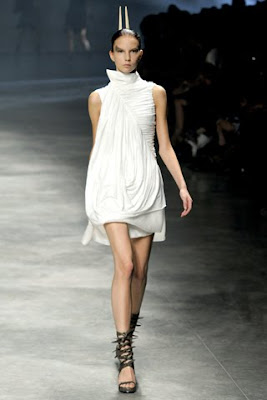Rick Owens
PARIS, September 30, 2010
"I started with abandon. Now I'm more interested in control," Rick Owens said, contemplating his new collection. That, in a nutshell, is the passage from youth to maturity. Still, as you age, you realize complete control is an impossibility, and yet you pursue it anyway, which inspires the melancholy of futility. How many fashion designers can you attach that weight to? That feeling surely explains the mysterious tug of a Rick Owens collection, and it's the magic element that will always give him the edge on his many imitators. This time, the evolution—abandon to control—was crystal clear. Where once his clothes were languid and drapey, now Owens favored a rigid, almost austere structure. Reemploying the silk cotton canvas from his recent men's collection, he cut shapes that stiffly framed the body, with collars that extended skyward. Skirts were extreme, either in volume or length, fishtails trailing in perverse defiance of common sense. But then Owens offered a group of mid-thigh styles, fabric folded to form a split tuniclike kilt—it was as commercial as anything he's ever done, especially when paired with pearly-toned leather jackets.
The dominant principle of the collection was aerodynamicism. It was implicit in the makeup and the hair; combs of bone rose from Luigi Murenu's chignons like alien tiaras—or antennae. But there were also cutaway leather tops and strapless columns that fell away in wings of fabric. Owens had seen the Picasso show at Gagosian in London this summer and been taken by the cardboard cutouts of white doves. That's the kind of subtle transmutation that makes his collections so haunting. And, because every detail is more thoughtful here than at many design houses, the soundtrack—Nathan Fake's "The Sky Was Pink," a piece of electronica whose innate lyricism has been mutated but never matched by multiple remixers—seemed significant. A hard, mutant lyricism is part of the unique appeal of Rick Owens.

















No comments:
Post a Comment